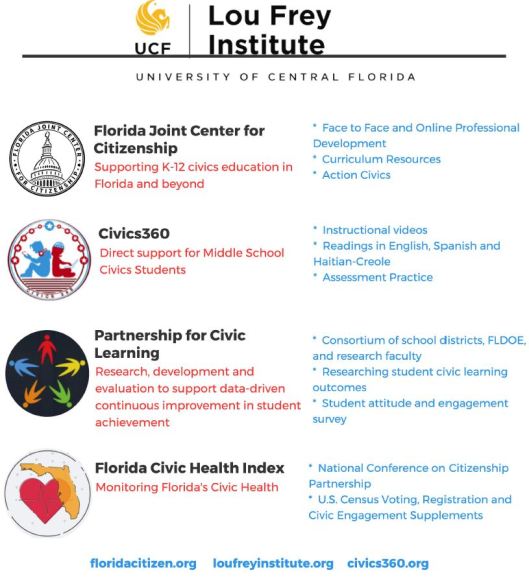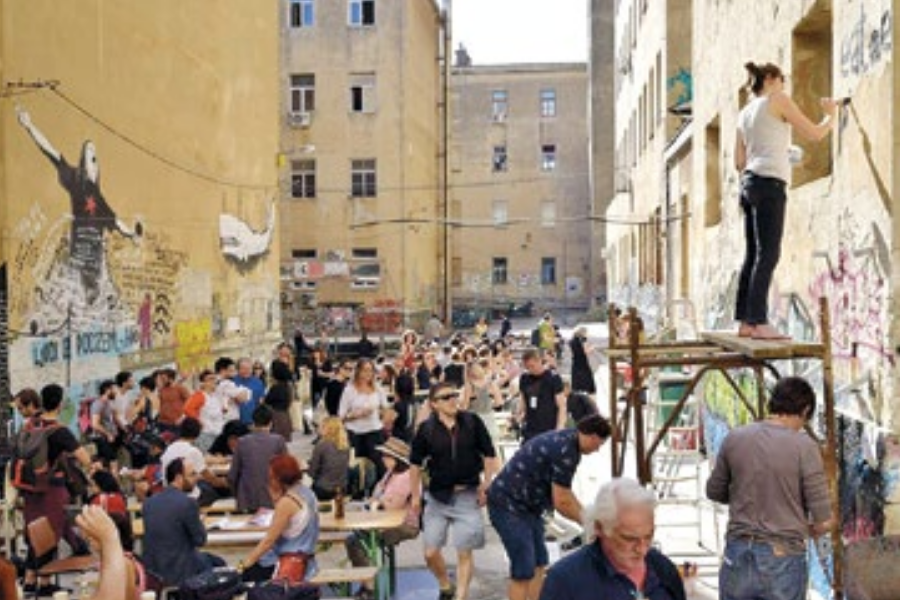
Good afternoon, dear friends in civics. Today’s post is response to this positive and supportive piece published in recently in Florida Politics. As you are most likely aware, the Lou Frey Institute/FJCC has faced a continual budget issue for the past few years. The linked Florida Politics post argues for ensuring that the Florida Joint Center for Citizenship is fully funded:
According to the Lou Frey Institute, when teachers use their resources, students score 20-25 percent higher on Florida’s end-of-course civics assessment.
Civics education is at the core of everything we are as a society. It’s about the law and the Constitution. It’s about voting and free speech. It’s about free expression of religion and speaking up freely to the government itself. In other words, it’s about America.
The Legislature requires civics education for millions of Florida children. In light of that, cutting funding for a resource that’s shown long-term significant ability to improve civics education seems to be an unwise and uncivil course of action….
Legislators should not be punishing an outstanding institution that is working hard to right the ship. FJCC conducts civics education under the names of two of Florida’s most civic-minded leaders of the past 40 years. Bob Graham and Lou Frey, a Democrat and a Republican, understood how government can be an instrument for good when used properly and in a limited way to find creative, workable solutions to problems.
They certainly understood the importance of the saying long popular around the Capitol: ‘Don’t throw the baby out with the bathwater.’ The Florida Joint Center for Citizenship did nothing wrong — but rather does so much right.
It would be a shame to see it, and the children who benefit from its programs, penalized for mistakes and misdeeds unrelated to its fine work and mission.
We greatly appreciate this support. But it’s time, perhaps, for a refresher on the work we do here at LFI/FJCC, a proud partner of the Civics Renewal Network (and be sure to check out their materials!) So, just what do we do? What does this funding support?
K-12 Civic Education Resources



You may be most familiar with us from our resources, provided to teachers of all grade levels. Every resources or tool we develop is created in response to a request to meet a need and in collaboration with teachers, teacher educators, and social studies/civics professionals. These curricular resources, available on our main website, are 100% free (though registration is required) and include, but are not limited to:
- Civics in a Snap (CIAS): 15 to 20 minutes ‘mini-lessons’ that address the civic benchmarks and are aligned with Florida’s ELA Standards (and easily adaptable to Common Core and the social studies standards of other states)
- Students Investigating Primary Sources (SIPS): This series of lessons, which range from 2nd through 12th grade, introduce students to primary sources around a variety of topics. They are intended to be somewhat short and simple to use while still providing some level of rigor. They are aligned with Florida’s ELA and social studies benchmarks (for civics, government, and/or US history)
- Civics Correlation Guide to Current K-5 Reading Series: This resource is connected to all current K-5 reading series being used in Florida, and illustrates will you will find some level of alignment with civics benchmarks.
- K-5 Civics Modules: These extended lessons are aligned with civics and ELA benchmarks.
- 7th Grade Applied Civics Resources: Here, you will find 35 lessons that have been developed to teach, with fidelity, the assessed civics benchmarks. On the page link provided, you will find lesson plans, power points, teacher-oriented content videos, and assessment items, among other things.
- Civics Connection: Developed in partnership with College Board and the United States Association of Former Members of Congress, the Civics Connection provides video-based, internet-delivered set of lessons that engages former members of Congress to help high school students understand Congress and the issues it faces. Videos and resources are aligned to the AP U.S. Government and Politics curriculum and may be used in other government classes as well.

Perhaps our most popular resource is Civics360. So what tools do you find on Civics360?
- Multiple Student Friendly Readings for each assessed benchmark, available in English, Spanish, and Haitian Creole

- English language reading guides for each Student Friendly Reading, developed with all levels of readers in mind

- Vocabulary Practice Worksheets that use Concept Circles to assist students with understanding key words from the benchmark

- A Quizlet tool for vocabulary practice and remediation

- Narrated student-oriented videos for every benchmark, with scripts to allow for reading along with the video

- Video Viewing Guides for each new video to facilitate engagement

- Online quiz practice within each module that reflect best practice in learning and assessment tools that facilitate engagement and retention. We have added clearer explanations and suggestions for reflection for every distractor in each question.

-
- Stand-alone ‘Showing What You Know’ activities for the following benchmarks: 1.3 (Road to Independence), 1.5 (Articles), 1.6 (Preamble), 1.7(Limits on Gov Power), 2.4 (The Bill of Rights), 3.1(Forms of Gov), 3.2 (Systems of Gov), and 3.4 (Federalism). Look for the ‘Showing What You Know’ section on each module page!

- Additional civic resources to facilitate learning and review

- Organized into 9 Civics Focus Areas that reflect district pacing guides

The site also includes a 60 question practice assessment that reflects the actual EOC in structure and format.

Be sure to check out the overview video!
The use of these resources in the middle school civics classroom does, we believe, have something of an impact, especially in conjunction with professional development.

In Monday’s post, we’ll explore some new directions for LFI/FJCC in the action civics arena and discuss the types of professional development that we can provide!


 Announcing This Years’ Finalists! These 20 communities get the chance to be named an All-America City
Announcing This Years’ Finalists! These 20 communities get the chance to be named an All-America City College student CGA forum series
College student CGA forum series

 Tuesday, April 2nd
Tuesday, April 2nd Thursday, April 4th
Thursday, April 4th NWOC is a bold annual occasion when people with diverse perspectives #ListenFirst to understand. Through in-person and virtual conversations exploring any topic of interest, people of all stripes intentionally convene with the goal of mending our frayed social fabric and revitalizing America together. We are encouraging everyone and anyone to reach out to neighbors, family and friends, and form your own conversations. To connect with this sweeping cross country movement, you can
NWOC is a bold annual occasion when people with diverse perspectives #ListenFirst to understand. Through in-person and virtual conversations exploring any topic of interest, people of all stripes intentionally convene with the goal of mending our frayed social fabric and revitalizing America together. We are encouraging everyone and anyone to reach out to neighbors, family and friends, and form your own conversations. To connect with this sweeping cross country movement, you can 
